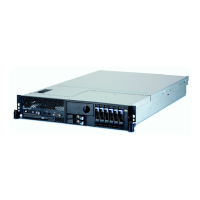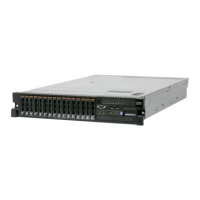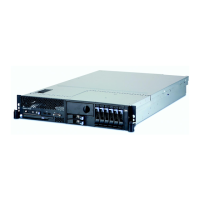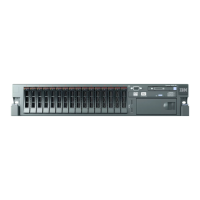– Non-mirroring mode. When you use the non-mirroring mode, install DIMMs
as indicated in the following table:
Table 16. Non-mirroring mode DIMM population sequence for the MAX5 memory expansion
module
Pairs of DIMMs DIMM connector population sequence
Pair 1 28, 29
Pair 2 9, 16
Pair 3 1, 8
Pair 4 20, 21
Pair 5 26, 31
Pair 6 11, 14
Pair 7 3, 6
Pair 8 18, 23
Pair 9 27, 30
Pair 10 10, 15
Pair 11 2, 7
Pair 12 19, 22
Pair 13 25, 32
Pair 14 12, 13
Pair 15 4, 5
Pair 16 17, 24
Note: When you populate DIMMs in the MAX5, populate the larger capacity
DIMMs first; then the smaller capacity DIMMs.
– Memory-mirroring mode. When you use the mirroring mode feature,
consider the following information:
- Memory-mirroring mode replicates and stores data on sets of DIMMs
simultaneously. If a failure occurs, the memory controller switches from the
primary set of DIMMs to the backup set of DIMMs. To enable memory
mirroring through the Setup utility, select System Settings → Memory. For
more information, see “Using the Setup utility” on page 132.
- DIMMs must be installed in sets of four. The DIMMs in each set must be
the same size and type. This is applicable also when the MAX5 expansion
module is attached to a host server and the host server has an optional
memory tray installed in the server. You must install DIMMs in sets of four
DIMMs for memory-mirroring mode in each (server, memory tray, and the
MAX5).
- The maximum available memory is reduced to half of the installed memory
when memory mirroring is enabled. For example, if the MAX5 expansion
module has 64 GB of memory installed, only 32 GB of addressable memory
is available when you use memory mirroring.
- The following table lists the DIMM installation sequence for
memory-mirroring mode.
122 System x3690 X5 Types 7147, 7148, 7149, and 7192: Installation and User's Guide

